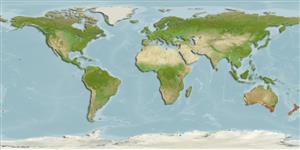Common names from other countries
分类 / Names
俗名 | 同种异名 | Catalog of Fishes(属, 种) | ITIS | CoL | WoRMS | Cloffa
Teleostei >
Scombriformes (Mackerels) >
Arripidae (Australian salmon)
Etymology: Arripis: Latin, arripio, arripere = to take something suddenly.
More on author: Forster.
Environment: milieu / climate zone / depth range / distribution range
生态学
海洋; 半咸淡水; 溯河洄游 (Ref. 51243); 深度上下限 30 - 39 m (Ref. 58489). 亞熱帶的; 27°S - 47°S, 112°E - 176°W
Southwest Pacific: southern Australia (including Tasmania, Lord Howe Island and Norfolk Island), usually Brisbane to Western Victoria, rarely to Western Australia; and New Zealand (including Chatham and Kermadec Islands).
西南太平洋: 澳洲 (包括塔斯梅尼亞,羅得豪島與諾福克島) 南部, 通常對西方維多利亞的布理斯班, 很少地到澳洲西部; 而且紐西蘭 (包括 Chatham 與科瑪狄克群島).
Length at first maturity / 大小 / 重量 / 年龄
Maturity: Lm 32.5, range 29 - 36 cm
Max length : 89.0 cm TL 雄鱼/尚未辨别雌雄; (Ref. 27296); common length : 47.0 cm TL 雄鱼/尚未辨别雌雄; (Ref. 9258); 最大体重: 9.4 kg (Ref. 9988); 最大年龄: 26 年 (Ref. 9072)
背棘 (总数): 9; 背的软条 (总数): 15-17; 臀棘 3; 臀鳍软条: 9 - 10; 脊椎骨: 25. Adults are dark blue-green above and silvery below, with irregularly defined spots arranged laterally in indistinct rows (Ref. 33616). Length of upper lobe of caudal fin < 29.9% SL, more or less equal to, or less than, the length fo the head (Ref. 9701).
成鱼是深蓝绿色上方与下面银色的, 在不明显的列中有不规则的侧面地被安排的清晰斑点.(参考文献 33616) 尾鳍上叶的长度 <29.9% SL, 约略等于, 以内比较, 长度 fo 头部.(参考文献 9701)
Inhabit continental shelf waters including estuaries, bays and inlets (Ref. 6390). Found between depths of 30 m (Ref. 33616) and 39 m (Ref. 58489). They enter rivers (Ref. 9002). Juveniles form school in shallow coastal bays and estuaries; adults move in large schools along shores (Ref. 9002), and can move over reefs in depths just sufficient to cover their bodies (Ref. 6390). They form large surface aggregations in deep water (Ref. 6390). Feed mainly on fishes but also on pelagic crustaceans, especially krill (Nyctiphanes australis). Take also food from the seabed. Fish smaller than 10 cm feed predominantly on copepods (Ref. 9072). Utilized fresh, canned and frozen; can be steamed, fried, broiled, boiled, microwaved and baked (Ref. 9988).
栖息于大陆架水域包括河口,湾内。 (参考文献 6390) 他们进入河。 (参考文献 9002) 稚鱼在水浅的近岸海湾与河口中形成鱼群; 成鱼沿着海岸 (参考文献 9002) 搬进大群鱼群, 而且能移动正好充份覆盖他们的身体礁深度之上.(参考文献 6390) 他们在深水中形成大的表面群集。 (参考文献 6390) 主要捕食鱼也捕食大洋性的甲壳动物, 尤其磷虾 ( Nyctiphanes 南极光 ). 也带食物从海底。 鱼比 10 公分小的主要以桡脚类的动物为食.(参考文献 9072) 生鲜使用, 罐装及冷冻; 能被蒸,油炸,火烤, 煮沸, 微波而且烧烤。 (参考文献 9988)
Life cycle and mating behavior
成熟度 | 繁殖 | 产卵场 | 卵 | 孕卵数 | 仔鱼
Eastern Australian salmon are probably serial batch spawners (Ref. 27961).西南太平洋: 澳洲 (包括塔斯梅尼亞,羅得豪島與諾福克島) 南部, 通常對西方維多利亞的布理斯班, 很少地到澳洲西部; 而且紐西蘭 (包括 Chatham 與科瑪狄克群島).
Paulin, C., 1993. Review of the Australian fish Family Arripididae (Percomorpha), with the description of a new species. Aust. J. Mar. Freshwat. Res. 44(3):459-471. (Ref. 9701)
CITES (Ref. 128078)
Not Evaluated
人类利用
渔业: 商业性; 游钓鱼种: 是的; 诱饵: usually
更多信息
合作者照片Stamps, Coins Misc.声音神经毒速度泳型鳃区Otoliths脑重体重比眼睛色素
工具
特别资料
下载 XML
网络资源
Estimates based on models
Preferred temperature (Ref.
115969): 15.6 - 22.3, mean 17.4 (based on 14 cells).
Phylogenetic diversity index (Ref.
82804): PD
50 = 0.6250 [Uniqueness, from 0.5 = low to 2.0 = high].
Bayesian length-weight: a=0.00955 (0.00352 - 0.02589), b=3.01 (2.79 - 3.23), in cm Total Length, based on LWR estimates for this (Sub)family-body shape (Ref.
93245).
营养阶层 (Ref.
69278): 4.1 ±0.6 se; based on diet studies.
回复力 (Ref.
120179): 中等的, 族群倍增时间最少 1.4 - 4.4年 (K=0.2-0.3; tm=4).
Prior r = 0.47, 95% CL = 0.31 - 0.72, Based on 2 stock assessments.
Fishing Vulnerability (Ref.
59153): Moderate vulnerability (37 of 100).
Climate Vulnerability (Ref.
125649): Very high vulnerability (100 of 100).
